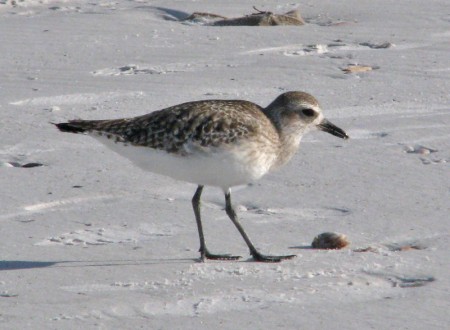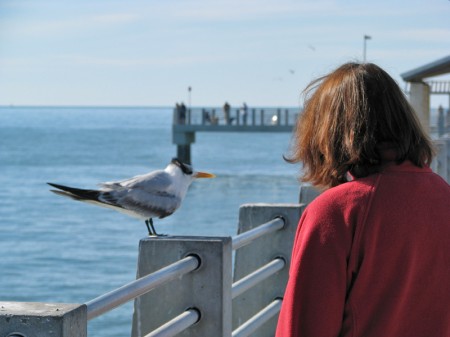Fort Desoto County Park is one of the Nation’s top birding locations. In addition to having lots of permanent resident bird species, many migratory species stop by the park on their way to other more exotic locations.
On Thanksgiving Day we took a drive out to Fort Desoto Park–it’s only 30 minutes from our house–and took a walk on the pier, the fort, and the beach. We saw a lot, and I’m posting a few photos that I took.
At left is a juvenile hawk that was perched on a telephone wire by the roadside. I’ve struggled to identify it. I believe it is either a Red-tailed hawk, a Red-shouldered hawk, or a Broad-winged hawk. At first, I leaned strongly towards it being a Red-shouldered, mainly because they are the most common, and because they are a bit larger than a Broad-winged hawk. This was a fairly large hawk. However, the more I look at it and compare it to various web photos and my new Sibley Field Guide to Birds, the more I think it is a juvenile Red-tailed hawk.
The juveniles can be a challenge to identify.
Shorebirds, especially peeps, like the one below, can also be a challenge. I first thought this one might be a Semi-palmated sandpiper. It was on North Beach, just below the high tide line, pecking at objects on the beach. At first, I thought there were two other sandpipers it could be: a Least sandpiper, or a Western sandpiper. However, the Least sandpiper has yellow legs, and the Western sandpiper has a longer bill, according to my field guides.
After reading the size information about these sandpipers, I had to reconsider. The Semi-palmated AND the Western are only about 5 inches long. This bird was definitely larger, so I had to look for a larger bird. I’ve now decided it is a Black-bellied plover, which is described as being about 9 inches long. This bird was every bit of 9 inches. To further strengthen my case, after looking at photos of all 3 species on the web, I see clearly that the Black-bellied plover has a thicker bill, which matches this bird.

Black-bellied plover?
Out on the Gulf Pier we saw lots of gulls, Snowy egrets, Brown pelicans, and terns. Below, Sue approaches a a tern to see how close it will allow her to get. It flew away when she got to the 3-4 foot range. This appears to be a Royal tern.
Fort Desoto’s North Beach is also a fairly good place to find shells. Below are pictured the most commonly found shells of the day, clockwise from the bottom: Sunray Venus clam, scallop, Jingle shell, Surf clam.
I picked up the scallop, then put it back on the beach. While I was stooped over, I picked up the other shells and put them all together for this photo. If you come to the park once a week, you’ll find different shells each time. During the summer we find lots of Olive shells, but I didn’t see any on this day.

Assorted shells found on Fort Desoto Park’s North Beach.
To give you an idea of what the North Beach area looks like, and to see why it has such a diverse bird population, I took a short panoramic video of the area. You can see the beach, mangroves, small dunes, a tidal lagoon, mud flats, and an Australian Pine forest in the distance, near the picnic area. If you look really closely, you can see several white egrets wading in the lagoon. The video rendered slightly jumpy on uploading, but there’s not much I can do about it. It’s good enough to give you a general impression of North Beach.
Fort Desoto Park: North Beach’s Diverse Habitat for Birding from David McRee on Vimeo.




